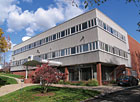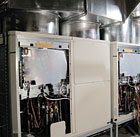
WOOD-TV8 was the first station to provide western Michigan with color television in 1953; as TV technology evolved, the station’s HVAC needs evolved as well. The station was retrofitted with a VRF system from Mitsubishi Electric.
GRAND RAPIDS, Mich. - In 1953, WOOD-TV 8 was the first station to provide western Michigan with color television. WOOD, based in Grand Rapids, Mich., is an NBC affiliate providing 24-hour news, events, weather, traffic, and sports. As TV technology has continued to evolve, WOOD has faced increasing problems in maintaining comfort within its facility. In 2008, WOOD’s longtime HVAC contractor, Seaman’s Air Conditioning & Refrigeration Inc. (Grand Rapids, Mich.) decided a major retrofit was needed to solve the station’s comfort problems.
TV STATION CHALLENGES
The use of machines and systems has always impacted the station’s operation. Flat panel TV technology introduced many additional electronic devices - all generating significant heat - to support news, weather, and sports. Live segments from the newsroom and sports desk meant increased high-powered lighting for these areas, resulting in added heat and significant comfort issues.As new technology was added, the challenge to keep on-air personalities cool and comfortable became more difficult. Meeting the cooling needs in the studio with traditional systems caused noise problems, and the air conditioning had to be turned off during the broadcast to maintain quiet. With two-hour news broadcasts, studio temperatures would rise resulting in comfort concerns for studio personnel. As HVAC systems were adjusted to accommodate the on-air broadcasts, comfort for other station personnel became a problem. Temperature complaints were an everyday occurrence, and the increased cooling requirements resulted in soaring energy bills.
For many years, Pat Murphy, an account manager at Seaman’s, had been working to meet WOOD’s ever-changing needs. By 2008, he decided it was time to stop using piecemeal fixes when major changes were needed. Working closely with WOOD’s engineering staff and operating departments, Murphy identified the concerns and goals that needed to be tackled in this project.
His mandatory checklist included the following: improved comfort for personnel throughout the station, especially the on-air personalities; lower energy costs; noise-free HVAC operations in all broadcasting studios; scalable, flexible HVAC systems to accommodate constantly changing requirements for WOOD’s future operations; control options to monitor system operation at each employee location in the building; minimal equipment footprints since space was a critical issue; and no disruption of station operations during installation.

Whisper-quiet
HVAC operations are requisite in a television studio. Seven of these PLFY
ceiling-recessed indoor units provide the station with great comfort and
virtually silent operation.
Murphy and Hoogewind had one other key consideration guiding their decision to specify the Mitsubishi Electric VRF (variable refrigerant flow) system. The 55-year-old building is totally surrounded by the high-end, vintage Victorian homes of Grand Rapids’ Heritage Hill neighborhood, so the new HVAC equipment and technology had to have very little impact on its surroundings.

Three
PKFY wall mounted indoor units provide the station with ductless flexibility
and adaptability.
VRF MEETS HVAC NEEDS
At the WOOD TV station, Seaman’s installed one PURY R2-Series outdoor unit, three PKFY wall-mounted indoor units, six PEFY ceiling-concealed indoor units, and seven PLFY ceiling-recessed indoor units. Murphy explained how this Mitsubishi Electric VRF zoning system provided the efficiency needed to meet all the challenges of the WOOD installation.He noted that industry research has demonstrated that VRF systems are consistently 30 to 40 percent more efficient than traditional systems. Fixed-speed compressors in traditional HVAC systems are either “off” or “on,” wasting huge amounts of energy when operating under part load conditions. Statistics show that partial load conditions exist 97 percent of the time at most locations. Mitsubishi Electric compressors operate with super-efficient inverter technology. This means the compressors ramp up quickly, providing the exact energy necessary to achieve the cooling or heating demand of each zone. Then, working in tandem with system controls and sensors, the inverter compressor varies its speed to maintain the desired comfort level.

Because
of the often severe Michigan winters, the design engineer decided to put the
20-ton Mitsubishi Electric PURY outdoor unit in a basement mechanical
room.
The system’s flexibility makes it easy to add, change, or remove zones, so it can be adapted for the ever-changing comfort requirements at WOOD. Its two-pipe heat recovery system makes it easy to install and maintain. Besides the simple piping, only non-polar, two-wire control connectors are required between the outdoor condenser and indoor air-handling units. The system uses a modular design where multiple outdoor units can be connected together to create larger sizes. These outdoor systems can be connected to a variety of indoor unit styles to fit the needs of the building.
And each Mitsubishi Electric VRF system can be configured for up to 16 zones within a building. Multiple VRF systems can be integrated into the Mitsubishi Electric controls network to air-condition and manage up to 2,000 zones from a single networked computer using Mitsubishi Electric furnished software.

For
system simplicity and flexibility, each Mitsubishi Electric VRF system can be
configured up to 16 zones within a building.
MICHIGAN WINTERS: PUTTING THE OUTDOOR UNITS INSIDE
Because Michigan winters are often severe, design engineer Scott Hoogewind decided to place the 20-ton R2-Series (PURY-240) outdoor unit in a basement mechanical room of the WOOD building. A unit that is capable of simultaneous cooling and heating, the PURY generates a capacity of 240,000 Btuh for cooling and/or heating.Hoogewind explained that the Michigan environment has an ambient design condition of 0°F, so using heat pumps in Michigan takes special design considerations.
“These units sit indoors to eliminate excessive winter ambient conditions when they are operating in heating mode, and the condenser fan motors modulate to move just enough air to meet capacity needs,” he said. Additional waste heat in the mechanical room from the other building systems helps to supplement the unit.
“While the Mitsubishi Electric system actually works very well at extremely low temperatures and does not have to be placed indoors, here in Michigan, about 30 percent of the heat pump installations have the outdoor unit placed indoors. In dealing with air-source equipment [PURY models], by placing the outdoor units indoors [in a mechanical room, etc.], we can better control the heating capacity adjustment due to the cold ambient temperature, unlike if they were placed outdoors.
“The Mitsubishi Electric system allows, through the use of dip-switch settings, ductwork to be added to the unit up to an external static pressure of 0.24 inches of water column,” Hoogewind added.

The
on-air personalities were all smiles following the Mitsubishi Electric VRF
installation because they were finally comfortable.
HAPPY CUSTOMERS
All of Murphy’s goals were met with the Mitsubishi Electric VRF system, and the project was completed in May 2010.After the installation, the on-air personalities reported great relief, and because of the system’s virtually silent operation, there is now plenty of comfort during broadcasts, which is a huge accomplishment according to Mike Laemers, WOOD’s chief engineer.
The many features of the VRF system helped WOOD achieve its energy savings goal - in the range of 30 to 35 percent, Laemers estimated. Shifting heat from areas with excess heat (due to all the electronics and lighting) to areas that needed the heat saved significantly on the energy bottom line. The ability to cool some areas while heating others at the same time has been a real plus, Laemers reported. Complaints about temperature and comfort have virtually disappeared and the facilities manager has the ability to set and monitor comfort settings for each room and ensure predetermined settings are being maintained.
“The VRF systems’ modular design has also solved the problem of the HVAC system’s flexibility and adaptability,” Laemers said. “As areas need to be remodeled, it is a simple matter of relocating the units and the line sets without having to change any duct work, because there is no duct work required.”
And finally, Laemers was especially pleased that there was zero impact on the station’s operation during the installation. The old system was left in place and operating throughout the installation. Once the Mitsubishi Electric VRF system was up and running and put through its paces, the demolition and removal of the old system began.
Publication date:04/25/2011

Report Abusive Comment